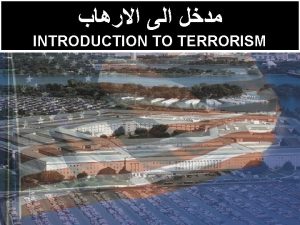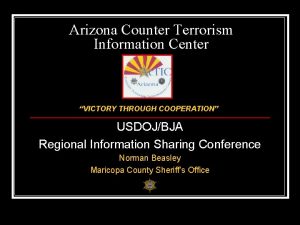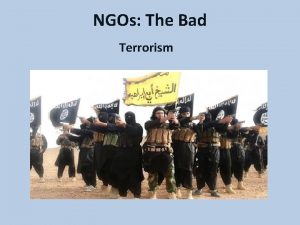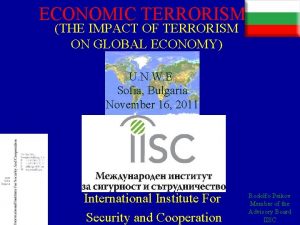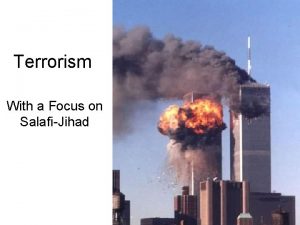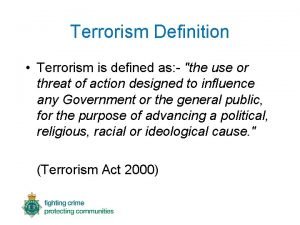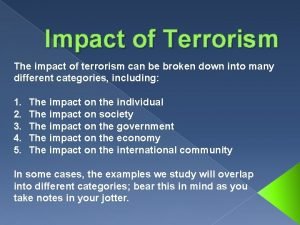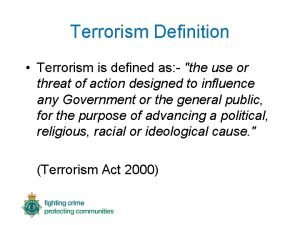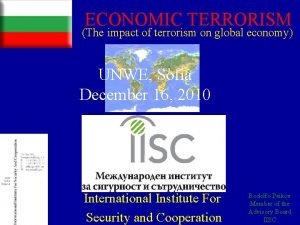Access code for quiz TERRORISM 34 6 TERRORISM































- Slides: 31

Access code for quiz: TERRORISM 34 6

TERRORISM DR FABIO SCARPELLO WEEK 7 WHAT IS THE GLOBAL SALAFI -JIHADIST MOVEMENT AND HOW DANGEROUS IS IT?

AIMS q Reflect on whethere is a causal link between Islam and terrorism q Analyse the differences between Islamic militants and the global Salafi-Jihadist movement (GSJM) q Reflect on the level of threat it poses to the West

OUTLINE q What is a social movement q The GSJM’s key characteristics q The GSJM main actors and layers q The genesis of the GSJM q Why is the GSJM so difficult to end q The level of threat it poses to

SOCIAL MOVEMENT

SOCIAL MOVEMENT q Large informal groupings of individuals or organizations that focus on specific political or social issues. They carry out, resist or undo social change q Movements are fluid with blurred boundaries They transcend organisations and individuals q Mobilised behind one overarching ideology, and more or less well defined goals q They benefit from strong leadership and resources q They implement various tactics and strategies to purse their political goals q Several theories explain how and why social movement emerge. One of them is theory or

KEY CHARACTERISTICS OF THE GLOBAL SALAFIJIHADIST MOVEMENT

KEY CHARACTERISTICS OF THE GSJM q Ideology q. Political aim q Strategy q Leadership and resources

KEY CHARACTERISTICS OF GSJM IDEOLOGY q Salafi jihadism q Salafism is a strand of Sunni Islam that advocates a return to the traditions of the Salafi, the first three generations of Muslims* q The Salafi movement is often divided into three subcategories: purists, activists and jihadists q Salafi-jihadists advocate armed struggle to restore the early Islamic movement. It is the smallest subcategory of Salafism, constituting less than 1. 0 percent of the world's 1. 2 billion Muslims q Salafi-jihadists reject any engagement in politics and non. Salafi interpretations of Islam. Many Islamic militant groups

KEY CHARACTERISTICS OF GSJM POLITICAL AIM q Its key political aim is the establishment of a supranational caliphate* q Salafi-jihadist groups may fight on local fronts, but as part of a global war q Only groups that share this transnational political aim are to be considered part of the GSJM

KEY CHARACTERISTICS OF GSJM STRATEGY q The strategy to achieve this s a war of all Muslims against illegitimate, idolatrous Muslim rulers, i. e. violent jihad and no political engagement. q The West is targeted for its presence in Muslim countries and its support for illegitimate Muslim leaders q The strategic logic is that, unless the West is defeated or weakened, these Muslim rulers will be propped up and the caliphate cannot be established

THE GLOBAL SALAFIJIHADIST MOVEMENT

THE GLOBAL SALAFIJIHADIST MOVEMENT q Al-Qaeda and the Islamic State in Iraq and Syria (ISIS) q The networks of affiliates and adherents groups of Al-Qaeda and ISIS q Groups that have remained separate from Al-Qaeda and ISIS, subscribe to the Salafi-jihadist ideology, aims and strategy q Salafi-jihadist lonewolves and homegrown cells in the West

THE GLOBAL SALAFI-JIHADIST MOVEMENT AL-QAEDA q Still very relevant. Changing and adapting q Focused on joining local insurgencies rather than usurp them q Reluctant to fight too many enemies at the same time q Focused on fighting near enemy governments, rather than far enemy governments like the United States q Attempted to leverage social media and other forums, though not as successfully as ISIS

THE GLOBAL SALAFI-JIHADIST MOVEMENT AL-QAEDA-AFFILIATED ORGANISATIONS q Al Qaeda in the Islamic Maghreb (AQIM) q Al Qaeda in Yemen (AQY) q Al-Qaeda in the Arabian Peninsula (AQAP) q. Al Qaeda Kurdish Battalions (AQKB) q Al Shabaab

THE GLOBAL SALAFI-JIHADIST MOVEMENT ISIS q Still very relevant despite loss of territory q ISIS’s organizational structure fairly decentralized. Local provinces/affiliated groups have autonomy to run daily operations q ISIS established a “virtual caliphate” across countries and continents via social media and encrypted communications q It has shifted from conventional war to guerrilla warfare and terrorism

THE GLOBAL SALAFI-JIHADIST MOVEMENT ISIS-AFFILIATED ORGANISATIONS q Ansar al-Islam q Islamic State Libya q Islamic State Sinai q Islamic State Khorasan q Islamic State West Africa q Islamic State Greater Sahara

THE GLOBAL SALAFI-JIHADIST MOVEMENT NON-AFFILIATED ORGANISATIONS q Hay'at Tahrir al-Sham (Formerly Jabhat al-Nusra) q Tehreek-E-Taliban Pakistan (TTP)

THE GLOBAL SALAFI-JIHADIST MOVEMENT LONEWOLVES AND HOMEGROWN CELLS

THE GLOBAL SALAFI-JIHADIST MOVEMENT THE CASE OF AFRICA

THE GENESIS OF THE GSJM

THE GENESIS OF THE GSJM q Post-Afghanistan local jihads in the early 1990 till mid-1990 s q Al-Qaeda targets the Far Enemy from mi-1990 s until 2001 q US invasion of Iraq in 2003 q The collapse and suppression of the Arab

THE GENESIS OF THE GSJM

WHY IS THE GSJM SO DIFFICULT TO END

WHY IS THE GSJM SO DIFFICULT TO END q Violent political conflicts in the Middle East q Escalating geopolitical rivalries in the Middle East q Sunni-Shia sectarianism at historical high q Sunni Arabs’ profound sense of victimisation q Ongoing authoritarianism, post-Arab Spring q Weak states in Africa q Ideological space for Salafi-jihadists

THE LEVEL OF THREAT

THE LEVEL OF THREAT WORLDWIDE q Deaths from terrorism have dropped since 2014. Deaths are now 44% below their peak in 2014 (Global Terrorism Index 2018) q Ten non-Western countries accounted for 82% of all deaths in 2017. This is an ongoing trend

THE LEVEL OF THREAT IN EUROPE q In 2017 a total of 205 foiled, failed and completed terrorist attacks were reported by nine EU Member States (EU Terrorism Situation & Trend Report 2018) q Only 16% of these were by jihadists

THE LEVEL OF THREAT IN THE USA q Spike in the number of attacks in the USA since 2015. In 2017 65 attacks were recorded q 37 were tied to Far-Right motivations and 11 attacks were inspired by left-leaning ideologies q Only 7 ere linked to Islamic extremist (Romero 2018)

KEY POINTS q The GSJM aims to establish a caliphate across the Middle East, parts of Asia and Africa. It is fragmented and presents deeps fissures. Yet, it is based on a shared ideology and strategies in support of its political aim q The Salafi-jihadist ideology is only embraced by about 1% of the Ummah q Al-Qaeda and ISIS are the leading groups of the GSJM. Each has affiliated groups operating rather autonomously. The GSJM includes unaffiliated groups and lonewolves and homegrown cells, the latter based mostly in Europe q The GSJM has deep roots, arching back to the anti-Soviet war in Afghanistan. The current phase is driven by the conflicts in the Middle East, geopolitical rivalries and the political space opened post-Arab Spring q The GSJM is a major threat for people in the Middle East and Africa. It is only a minor threat to Westerners

REFERENCES “Global Terrorism Index 2018. ” 2018. Sydney: Institute for Economics & Peace. http: //visionofhumanity. org/reports. “EU Terrorism Situation & Trend Report 2018. ” 2018. The Hague: Europol. https: //www. europol. europa. eu/activities-services/main-reports/eu-terrorism-situation-and-trendreport. Romero, Luiz. 2018. “US Terror Attacks Are Increasingly Motivated by Right-Wing Views. ” Quartz, October 25, 2018. https: //qz. com/1435885/data-shows-more-us-terror-attacks-by-right-wing-and -religious-extremists/.
 Terrorism definition
Terrorism definition Terrorism
Terrorism Terrorism
Terrorism ανσκ
ανσκ Arizona counter terrorism information center
Arizona counter terrorism information center Fighting terrorism
Fighting terrorism Code commit code build code deploy
Code commit code build code deploy Terminal access controller access control system plus
Terminal access controller access control system plus Terminal access controller access-control system
Terminal access controller access-control system Kontinuitetshantering
Kontinuitetshantering Typiska drag för en novell
Typiska drag för en novell Tack för att ni lyssnade bild
Tack för att ni lyssnade bild Vad står k.r.å.k.a.n för
Vad står k.r.å.k.a.n för Shingelfrisyren
Shingelfrisyren En lathund för arbete med kontinuitetshantering
En lathund för arbete med kontinuitetshantering Personalliggare bygg undantag
Personalliggare bygg undantag Personlig tidbok
Personlig tidbok Sura för anatom
Sura för anatom Densitet vatten
Densitet vatten Datorkunskap för nybörjare
Datorkunskap för nybörjare Stig kerman
Stig kerman Debatt mall
Debatt mall Magnetsjukhus
Magnetsjukhus Nyckelkompetenser för livslångt lärande
Nyckelkompetenser för livslångt lärande Påbyggnader för flakfordon
Påbyggnader för flakfordon Arkimedes princip formel
Arkimedes princip formel Offentlig förvaltning
Offentlig förvaltning I gullregnens månad
I gullregnens månad Presentera för publik crossboss
Presentera för publik crossboss Jiddisch
Jiddisch Kanaans land
Kanaans land Klassificeringsstruktur för kommunala verksamheter
Klassificeringsstruktur för kommunala verksamheter


